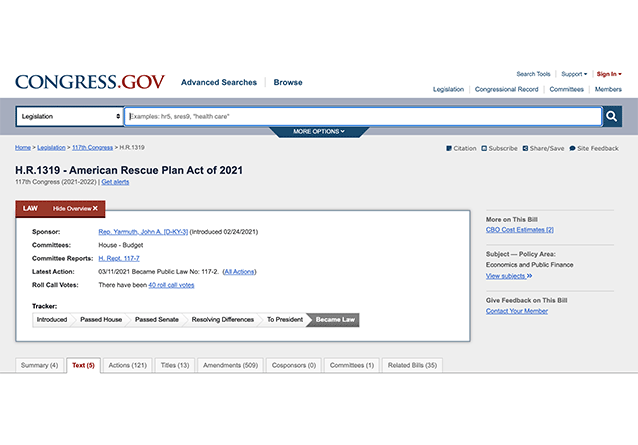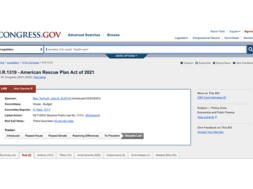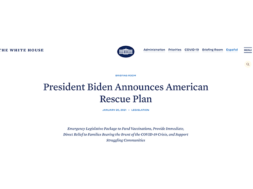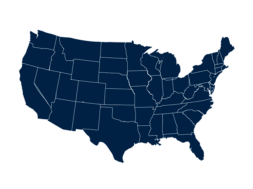
The Changing Landscape of the 90/10 Rule
By Michael Wherry, CPA, McClintock & Associates, P.C., Katherine D. Brodie, Partner, Duane Morris LLP, and Kristina Gill, Special Counsel, Duane Morris LLP
On March 14, 2021, President Biden signed into law the America Rescue Plan and, with it, ushered in a new era for the 90/10 Rule. Embedded in the education-related provisions of the bill is an important, but ambiguous, change to the 90/10 Rule that will require proprietary institutions to derive not less than 10% of their revenues for tuition, fees and other institutional charges from “federal education assistance” rather than federal Title IV, Higher Education Act (HEA) student aid (grants and loans) (“Title IV aid”). This article will review the scope of the 90/10 Rule, analyze the implications of the proposed change, and provide schools planning recommendations.
Background
The current 90/10 Rule in the HEA applies only to proprietary (i.e., “for-profit”) institutions of higher education and requires that, for each fiscal year, an institution derive at least 10% of its revenues for tuition, fees and other institutional charges from sources other than Title IV aid. The rule was originally proposed as a method for ensuring academic quality at proprietary institutions, the presumption being that students should be willing to pay at least 10% out of their own pockets towards their education if an institution is worthy of participating in Title IV aid programs. This is a dubious assumption and a discussion topic for another time.
As part of the statutory requirements for Title IV, HEA Program Participation Agreements under 20 U.S.C. § 1094(a)(24), and the implementing regulations at 34 C.F.R. §§ 668.14(b) and 668.28, proprietary institutions must derive at least 10% of their revenue annually from non-Title IV funds (i.e., no more than 90% of their revenue annually can come from Title IV funds) (“90/10 Rule”). Under the current 90/10 Rule, examples of non-Title IV funds include: student cash payments, state grants, private education loans and some military and veterans’ benefits, such as benefits provided under the Post-9/11 GI Bill program.
The sanctions for failing the 90/10 Rule are significant. If, in any single fiscal year, an institution does not derive at least 10% of its revenue from sources other than Title IV aid, it becomes provisionally certified for two fiscal years. After two consecutive years of failing the 90/10 Rule, the institution becomes ineligible for Title IV aid. Further, under the current Borrower Defense to Repayment Rule (34 C.F.R. § 668.171(d)), failure to satisfy the 90/10 Rule in any fiscal year constitutes a “Discretionary Trigger” that could lead to letter of credit of at least 10%. Institutions must disclose 90/10 rates in a note to their audited financial statements filed annually with the U.S. Department of Education and must disclose a failure of the 90/10 Rule within 45 days of the end of their fiscal year.
America Rescue Act – Enacted Changes
As originally proposed, Section 2013 of the American Rescue Plan Act amended the 90/10 Rule effective upon enactment such that all “federal education assistance” funds are counted on the “90 side” of the 90/10 calculation. Prior to passage, the Moran-Carper amendment added that all changes be subject to negotiated rulemaking and the Master Calendar requirements under section 482 of the Higher Education Act of 1965 (HEA). The amendment further directed that negotiated rulemaking shall commence not earlier than Oct. 1, 2021.
There are two important variables to consider in the Act as enacted: timing and scope.
From a timing perspective, we know that the Master Calendar requires that a rule be published in final form by November 1 of a given year in order to have a Final Rule effective date of July 1 of the following year.
If, for example, the Department of Education publishes a new 90/10 Rule by Nov. 1, 2022 (it cannot begin the process until Oct. 1, 2021), then the new rule will be effective on July 1, 2023. Uncertainty exists as to whether an institution with a December 31 fiscal year end would need to begin complying with the new regulations as of Dec. 31, 2023 or Dec. 31, 2024. We consider it likely that final rule might provide that the new regulation would be applicable for the Dec. 31, 2023 fiscal year end and strongly recommend that institutions plan accordingly with this timeframe in mind. The second variable is the precise definition of “federal education assistance” funds, which are limited to 10% of revenue under the Act. Notably, the term “federal education assistance” is not defined in the Act or the current regulations.
In considering the meaning of the definition, we look to two prior examples drawn from legislation introduced during the 116th Congress. H.R. 3368, Defending All Veterans In Education Act, introduced by then Representative Donna Shalala (D-FL) broadly defined “Federal funds” to mean “any Federal funds provided, under this Act or any other Federal law, through a grant, contract, subsidy, loan, guarantee, insurance, or other means to a proprietary institution, including Federal funds disbursed or delivered to an institution or on behalf of a student or to a student to be used to attend the institution.” The definition would exclude any monthly housing stipend provided under the Post-9/11 Educational Assistance Program. The AIM Higher Act (H.R. 6543) introduced by Chairman Bobby Scott (D-VA) would have defined “Federal education assistance funds” as (A) funds under Title IV; (B) educational and training benefits available to veterans, military personal, and other individuals under chapter 30, 31, 32, 33, 34, or 35 of title 38, United States Code, or chapter 101, 105, 106A, 1606, 1607, or 1608 of title 10, United States Code, or section 1784a of title 10, United States Code.
Neither of these bills were passed by Congress, but we view the variations in the definitions as instructive both to possible variances in the meaning of “federal” funds and also the potential reach an expansive rule could have to all types of federal funds.
It is important to note that, as of the time this article was written, a number of Senators are seeking to introduce and pass additional 90/10 legislation, prior to promulgation of the new rule, that would include a statutory definition of federal education assistance. As proposed by Senators Carper, Cassidy, Lankford, and Moran in the 116th Congress, the definition of federal education assistance would include “financial assistance that is disbursed or delivered to an institution or on behalf of a student or to a student to be used to attend the institution provided under any of the following provisions of law: (i) This title and (ii) Chapter 30, 31, 32, 33, 34, or 35 of title 38, United States Code, except that such term shall not include any monthly housing or book stipend provided under the Post-9/11 Veterans Educational Assistance.”1
It is worth noting that some states have advanced 90/10 legislation and the outcome of this legislation may become moot based upon the pending future changes to the federal regulations.
However, at the moment, institutions should not forget about state level legislation related to the 90/10 Rule.
Calculation
The auditing guidelines for the calculation are equally important to the potential scope of the definition. As any institutional financial analyst or auditor will know, the calculation is not self-evident and includes a number of nuances that drive the ratio. The 90/10 revenue percentage is calculated on a cash basis (where revenue is recognized in the fiscal year in which cash is received, regardless of when payments are due). (In our opinion, technically the calculation is a modified cash basis due to the treatment of credit balances as these are includable when they are utilized to pay for institutional charges. Credit balances which are ultimately provided to the student as a stipend are excluded from the calculation.) In calculating the revenue percentage, the numerator includes Title IV funds used for tuition, fees, and other institutional charges. The denominator includes total revenues generated by the institution from (1) tuition, fees, and other institutional charges for students enrolled in Title IV eligible programs and, in limited instances, in other educational programs; plus (2) activities necessary for the education or training of students enrolled in Title IV eligible programs. Income from institutional grants and scholarships (see presumptive rule discussion below), books and supplies (unless specifically included in tuition), state tuition savings plans, and certain federal contracts are not counted.
An institution may count as revenues in the calculation only revenues generated from programs and activities. Revenue from programs and activities include three types of revenues:
- Institutional charges – tuition, fees, other institutional charges (books and supplies such as room and board, if contracted with the school) for students enrolled in eligible programs
- If a fee (like a registration or technology fee) is re¬quired for all students in a program, then the fee is considered an institutional charge
- Revenues generated from other activities conducted by the institution that are related to the eligible programs
Revenues generated from activities conducted by the institution per 34 C.F.R. § 668.28(a)(3)(ii) that are necessary for the education and training of its students provided those activities are:
- Conducted on campus or at a facility under the institution’s control;
- Performed under the supervision of a member of the institution’s faculty; and
- Required to be performed by all students in a specific educational program at the institution.
It is critical that all three components above are met. For example, a student run restaurant which was hosted at a facility owned or leased by the institution and for which the educational instructors oversaw the operations, would normally meet these requirements. However, the revenue generated by a culinary school which provides catering services may not qualify if the catering services are not provided at a facility under an institution’s control or not all students were required to perform these services as part of the educational curriculum.
Only revenues generated by students can be counted, so institutions must segregate and exclude any revenues generated from instructors, graduates or professionals that may work in a clinic. ED has also indicated that product sales generated from student run clinics are not includable in the 90/10 calculation, only the service revenue component. In addition, pursuant to 34 C.F.R. § 668.28(a)(3)(iii)(A) to (E), revenue earned from educational programs that are not Title IV-eligible may be included in total revenue so long as the applicable program:
- Is approved or licensed by the appropriate state agency;
- Is accredited by a recognized accrediting agency; Provides an industry-recognized credential or certification, or prepares students to take an examination for an industry-recognized credential or certification issued by an independent third party (Example – training that leads to Microsoft certification or a bar review course);
- Provides training needed for students to maintain state licensing requirements (Example – continuing education programs required to maintain technical or professional certifications); or
- Provides training needed for students to meet additional licensing requirements for specialized training for practitioners that already meet the general licensing requirements in that field.
If an institution intends to include non-Title IV licensure and training revenue in the 90/10 calculation, this should be vetted thoroughly with regulatory counsel and your auditors. Not all non-Title IV training revenue will qualify, and evidence needs to support that this training is “part of” the Title IV authorized educational institution. Examples include updating websites, handbooks, catalogs, management oversight, etc. to support that the Title IV institution is ultimately providing this training. This documentation and support are even more critical if the non-Title IV training is provided by a separate subsidiary or division of the Title IV institution.
The calculation is further complicated by the presumption rule which requires that schools must presume that any Title IV program funds, or in the case of the proposed rule federal education assistance funds, it disburses to, or delivers to or on behalf of a student will be used to pay the student’s tuition, fees, or institutional charges regardless of whether the school credits the funds to the student’s account or pays the funds directly to the student.
Title IV funds, or federal education assistance funds, are and will likely be presumed to count first towards institutional charges, unless they are satisfied by:
- Grant funds from non-federal agencies or private sources independent of the school
- Funds provided under a contractual arrangement with a federal, state, or local government agency for the purpose of providing job training to low-income individuals in need of that training
- Funds from a Section 529 or other tax savings plans for educational expenses qualified under Internal Revenue Code, or Institutional scholarship that meet certain conditions
We do not anticipate a change to this guidance, which highlights the importance of these revenue streams for future compliance. Institutions should review all fund sources in detail to ensure you fully understand whether each one meets the presumptive rule and if the current presumptive rule treatment is at risk pending the future changes.
We are often asked about institutional scholarships. Currently, internal (or institutional) scholarships can only be counted in the 90/10 calculation if the scholarships were disbursed from an established restricted account and the funds in the restricted account are from an outside source or income earned on those funds. It is our observation that it is extremely rare in the for-profit school sector to have any substantial amount of internal scholarships that qualify under this provision. Institutional scholarships that aren’t funded from a restricted account or outside sources are just a noncash adjustment to a student’s account. Thus, since no actual cash was received by the institution, these internal scholarships aren’t included as a payment source in the calculation. They are excluded similar to a bad debt write-off.
Examples of grant funds for the student from non-federal public agencies or private sources independent of the institution include: employer scholarships, employer tuition payments, state grants, state scholarships, tribal funds, or private scholarships.
Due to the various nuances, the compilation of the 90/10 calculation must be performed on a student-by-student basis as this is required by the audit guide which governs the annual Title IV compliance audit. The calculation needs to properly capture the student’s institutional charges for the fiscal year along with unpaid institutional charges from the prior year and then apply any funds received during the fiscal year to “pay for” these institutional charges. As noted previously, funds received in excess of institutional charges are either credit balances held to a future period or stipend sent to a student which are excluded from the calculation. Using a student information system designed to compile the 90/10 calculation is the most efficient and accurate process. However, the calculation can be performed using an Excel template, but it may take a significant amount of manual entry if data can’t be exported from your current system or if the data isn’t coded in a consistent format. As a reminder, your financial statement auditor can’t compile the calculation for you. Thus, if you are unfamiliar with compiling a student-by-student 90/10 calculation and need detailed assistance, you may need to engage an outside consultant to assist.
As a side note, we believe ED does not plan to issue any relief for institutions which experienced an increase in the 90/10 rate due to the closure of a student run clinic because of the pandemic. In addition, any lost revenue claimed using the Higher Education Emergency Relief Funding 18004(a)(1) grant can’t be included in the 90/10 denominator as revenue. While it may be lost revenue, the HEERF grant does not meet the required definitions to include in the 90/10 denominator.
Recommendations
Based on the above discussion, any “crystal ball” is perhaps cloudy at best. With the significant uncertainty and unpredictability, the most prudent course is for institutions to evaluate a 90/10 revenue percentage based on the most conservative approach counting only those funds that are outside the most expansive definition of federal education funds.
We also recommend that institutions “pressure check” multiple scenarios for compliance that take into account the potential variations. For example, some proposals exclude monthly housing stipends provided under the Post-9/11 Educational Assistance Program. By preparing revenue assessments at the most granular level, institutions will gain a strong understanding of the revenue strength or weakness in light of the proposed changes. Many institutions will not have significant exposure from these changes. Some institutions, however, may find that they need to make adjustments going forward.
As a closing note, we also encourage institutions to actively engage in the negotiated rulemaking process by offering commentary, volunteering as a negotiator, and submitting public comments independently or through an association of which you are a member.
As seen from the legislation above, the elimination of the 90/10 Rule is unlikely to happen unless some other metric is developed. Institutions should reach out to your legislative representatives to educate them on the 90/10 Rule and why it is not a barometer of educational quality. In return, institutions should have a thought on what would be a better outcome measure. Accountability in higher education is not going away over the next decade.
Reference
- It is expected that this language will be included in legislation to be introduced in the 117th Congress.
MICHAEL WHERRY is a Director within the Audit Department and has over two decades of experience in the public sector. A Certified Public Accountant, Michael oversees the completion of annual audits (financial statement and student financial aid). Clients value his views on internal controls and processes, financial reporting under Generally Accepted Accounting Principles (GAAP), proactive solutions for meeting regulatory covenants, interpretation of standards and regulations, and suggestions to minimize compliance findings in student financial aid audits.
Michael is an active presenter at numerous national conferences and conventions, and holds both American and Pennsylvania Institute of Certified Public Accountants certifications. He is currently serving on the Pennsylvania Associations of Private School Administrators (PAPSA) Board of Directors, and was a past treasurer for a nonprofit family health care center in the city of Pittsburgh.
A Pennsylvania State University alumni association lifetime member, Michael enjoys spending time with his friends and family. A running and outdoors enthusiast, he has completed over 10 marathons and enjoys spending time working in his yard.
Contact Information: Michael Wherry // CPA // McClintock & Associates, P.C // 412-257-3680 // mwherry@mcclintockcpa.com // www.mcclintockcpa.com
KATHERINE D. BRODIE is Partner and Co-Lead of the Education Group at Duane Morris LLP. Her practice is devoted primarily to the needs of educational institutions (nonprofit, public and proprietary), education associations, education companies and investors in education. Ms. Brodie’s experience includes, among other areas of the law, those laws and regulations that directly impact educational institutions, including U.S. Department of Education regulations (Title IV student financial aid); Title IX compliance and response; Clery Act/campus safety; privacy and data security; accrediting agency standards including substantive change (ownership and governance, program, location and other changes); state licensing and authorization; admissions and marketing; online and hybrid education; foreign school and overseas operations including study abroad programs; OPM and partnership agreements; income share agreements; and skills-based, non-degree short term programs.
Contact Information: Katherine D. Brodie // Partner // Duane Morris LLP // 202-776-5241 // kdbrodie@duanemorris.com // https://www.duanemorris.com/
KRISTINA GILL practices in the Education Group at Duane Morris LLP. Her practice focuses on issues related to federal and state regulatory compliance, transactions, and education policy. Her experience and advice includes issues surrounding compliance with the federal regulatory process, particularly as related to the Title IV student financial aid programs authorized by the Higher Education Act and administered by the U.S. Department of Education.
Specifically, Ms. Gill counsels institutions regarding institutional, student and program Title IV eligibility requirements, including Title IV program review and audit response and resolution, Title IX (sexual harassment) and Clery Act (campus safety) compliance, Annual Safety Reports, EEOC complaints, change of ownership questions and approvals, incentive compensation, licensing requirements, state authorization (on-ground and distance education), DOD/VA educational benefit regulations, gainful employment compliance, and borrower defense to repayment issues. She also advises schools regarding consumer protection and disclosure regulations and trends, and a variety of other legal and regulatory issues impacting educational institutions, including marketing and advertising practices, and third party servicer relationships. She assists clients in providing formal responses to rulemaking and draft legislation.
As a former staffer on Capitol Hill, Ms. Gill brings an insiders perspective to the federal legislative process. She has a strong command of the intersection between policy and regulations. She works with clients to develop advocacy and engagement strategies for issues related to higher education and more specifically the reauthorization of the Higher Education Act. She is a speaker at higher education conferences on emerging and on-going regulatory issues impacting postsecondary educational institutions.
Contact Information: Kristina Gill // Special Counsel // Duane Morris LLP // 202-776-5246 // kgill@duanemorris.com // https://www.duanemorris.com/













